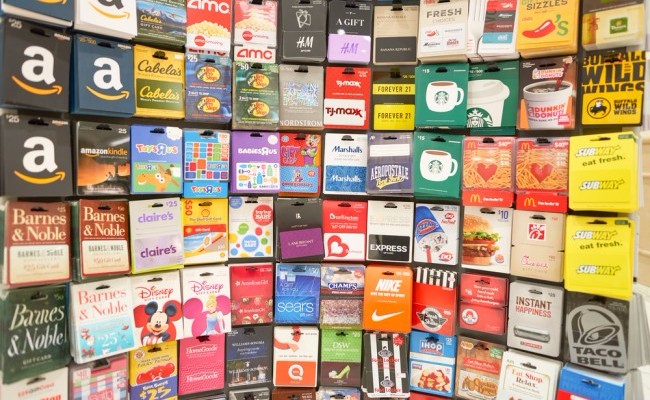When I was 22, I was in a Victoria’s Secret buying a new bra when I was offered an interesting proposition (though not like Penthouse forum letter interesting so… don’t get too excited). They told me that if I got a Victoria’s Secret credit card then I would get two free bras! All I had to do was sign up (I’d be approved in seconds, so easy!), and put this purchase on the card. Which, you know, I was about to pay for anyway, so I could easily pay it off online, right? That would be all it took to get two free bras. That was like $120, for doing nothing! How do you turn down that? I thought. So I signed up for my first credit card. And happily walked away with my purchase knowing that I had made an incredibly smart financial decision.
Then, I promptly forgot about that credit card, and did not think about it again for several years.
But wait, you mean AFTER you paid off that $48 dollars that you put on it, right? You paid it off, got your bras, and then never thought about it again?
NOPE. I left the store, and never let the thought of that credit card enter my brain again. That is, until I checked my credit score a couple of years later. That’s when I saw that my credit had tanked, and that I owed lots and lots of money on a Victoria’s Secret credit card that I had only a vague memory of opening.
But…didn’t you get a lot of bills and notices, collection letters and the like?
Presumably. But when I made that absolutely terrible decision, I was traveling around Montana. I didn’t have a permanent address and so….I have no idea what happened to those letters. I’m sure they went…somewhere.
So, in exchange for $120 dollars in bras, you ended up with hundreds of dollars in debt and bad credit?
Not quite! I never got the bras so….I got all that in exchange for absolutely nothing!
That’s really sad.
Yeah, yeah it is.

Look, I’m not good with finances. And I’m terrible with credit cards. To date, I have tried to open three cards in exchange for rewards. Victoria’s Secret (oops). A Bank of America Cash Rewards Card in exchange for a measly $100 dollar bonus (I just finished paying that one off last month…just three years and a few hundred dollars lost in interest later), and a Southwest Rapid Rewards Card for which I was denied. That last one was probably for the best, but at the time — a low moment in my credit life — I cried…a lot. I mean, I’m the perfect candidate for that stuff. I end up paying tons of interest and usually forget to reap any of the benefits. And still I could not give them my money. They were like, no, not you. YOU make us TOO nervous.
So when I encountered the idea of credit card churning recently (opening and then closing credit cards specifically to get the rewards), I was really, really skeptical. And I had lots of questions. Like is it humanly possible to keep track of all those cards? And how do you meet buying minimums? I needed answers. So I turned to credit card points expert, Bryce Conway, for answers.
Bryce runs a website called 10X Travel, a blog that helps people get the most out of credit card rewards point and frequent flyer miles. And he practices what he preaches. Bryce typically opens and closes about 20-30 credit cards per year. That may seem insane for the layperson, but he makes it work. In fact, he says, he literally can’t spend his points as fast as he gets them.
Most recently, he and his wife went to Thailand for two weeks. The price of their trip was over 28,000 dollars, but after their points and upgrades, they paid just $312 a piece.
“I stayed in a suite that’s bigger than my four bedroom house in Ohio,” Conway told me with a laugh. “It had three bathrooms.”
They were able to use points for first class plane tickets, room service, and tons of other excursions on the vacation. It was the kind of luxury trip that Conway (along with most of us) would never be able to afford normally, but with credit card churning, it was cheaper than a weekend in Cleveland.

For Conway, his journey to full time credit card churning started in the winter of 2011. He was a senior in college, and all of his friends were going to Florida for Spring Break. Conway wanted desperately to go with them. There was just one problem.
“I had like 60 bucks in my bank account,” he tells me. “So I literally just went to my computer and googled like ‘how to travel for free’ and ‘how to travel for cheap.'”
He figured there had to be some sort of work program he could try or… something.
“You hear about these kind of things that are like if you do two days of service work, they’ll fly you out,” he continues. “Or we’ll give you a free plane ticket if you carry a package on the flight.”
“Wait,” I interrupt him. “If you carry a package, we’ll pay for your flight? That sounds like you were googling how to become a drug mule.”
“To be honest, at the time, I might’ve considered it,” Conway says. He was that desperate. Luckily for him though, his googling presented another opportunity. “I couldn’t find anything,” he says. “I kind of was resolved like, I guess I’m not going to go on spring break this year. But from that point forward, I noticed that all of my pop-up ads were for airline credit cards. And they all said the same thing. If you open a card, we’ll give you a free flight.”
So Conway decided to take a chance on a Southwest rewards card offering him two free flights, and he was amazed at how easy it was. There seemed to be no downside (unlike my 22 year old self, Conway paid the card back). He got to go on Spring Break, he got a bonus trip to Vegas, and his credit actually went up. “I just thought to myself, wait, why would I not do this every time I want to travel?” he says.
So he did. He started joining community message boards that taught him how to hack the system and get all the rewards with minimal risk. And soon, his hobby was sending him all over the world for little to no money. His new life was pretty awesome, and friends started begging for advice. He realized there were lots of people out there who were interested in credit card churning but had no idea where to start. With that in mind, he joined up with a partner, wrote an instructional ebook, and started a website. His business now is focused around credit card points and churning, and he’s really successful at it. He opens dozens of cards a year, generally ones that are waiving fees for the first year, and then closes them before annual fees kick in. And with the best cards, usually you can wait a year or two, and reopen them for rewards a second time. So he makes laps.
Before I talked to Conway, I thought rewards credit cards were like going to Vegas. The house always wins, I assumed. But when you hear about it from Conway, it’s like you’re talking to someone who has learned how to count cards (and as of now hasn’t been kicked off the floor or had his legs broken by thugs… yet). He’s beating the house every time. So I asked Conway some questions to figure out exactly how we too can take advantage of credit card churning. And he outlined how easy it is to game the system.
Will opening and then closing credit cards so quickly affect my credit score?
Good question. The short answer is, yes, but not in the way that you think. Doing this (c.c. churning) will actually improve your credit score. Of course, with the major caveat that you’re not using these credit cards to go into major debt. It’s something I could talk about for hours … I actually just wrote a book on how to repair your credit. But the long and short of it is that most credit advice out there is really bad. There’s a lot of half-truths. The idea of closing a card hurts your score is a half-truth.
That is because if you close your oldest credit card, then yes, that will have a pretty significant impact on your score. But, because I’m constantly replacing new cards on my credit report, as long as I keep just my oldest two or three open long-term, just turning through new ones does not actually hurt your credit score. For me, I’ve seen it go up pretty dramatically.
You open so many cards. How do you keep track of what you’ve opened, buying minimums, and when to close them?
I use a spread sheet! We have one on our site that everyone gets when they join our mailing list and it helps track of when you opened the card, how much you have to spend, how many points you earned, and then a reminder of when you should close the card.
How do you reach the buying minimums needed to collect your rewards?
A lot of the people that I’m talking to say, “That’s great, Bryce, but I only spend like $1000 a month on credit cards, how can I do 30 cards a year if I have to spend an average of $3000 on each one to get the rewards?”
This is where the concept of Manufactured Spending comes in. Manufactured Spending is really just a way of buying some sort of cash fulfillment with your credit card, and then immediately turning around and paying off your credit card again. So, I’ll give you a good example. In the mid to late 2000s when I was first getting into this, you used to be able to buy $1 US coins from the mint on the internet with your credit card, and it was free shipping. So you could open the Southwest card, for example, and buy $2000 in coins. They’d show up on your front door and you’d take them straight to the bank, deposit them, and just pay off your Southwest card.
Of course, companies that are being used for just manufactured spending, when they figure out, “Hey, we’re losing money on this.” They close up the loophole. So that’s where there’s really an art to this, of travel hacking. They’re discussed regularly in our kind of community forums and on my website. You have to stay one step ahead of the game.
What’s the best way to manufacture spending right now?
The most common one used right now is a website called Tio. So, if you ever go to a pharmacy or grocery store, you’ll see a gift card rack, the kind of reloadable gift cards that your grandma would give you for your birthday. So, with a lot of those, you can load up to $500 on them. The purchase fee is like $4.95, so it’s about one percent. Now, what we’ll do is we’ll go into a store and we’ll buy thousands of dollars of these with the credit card you’re trying to hit a buying minimum for.
Then, you go home and log into a website called Tio. It’s a bill pay website that accepts debit cards. So we simply use the gift cards we just purchased in the store to pay off credit card bills. So it’s not free anymore, like it used to be in the heyday of buying coins or a couple other methods, but the total fee ends up being about 2.7 percent. So if you open, for example, a new credit card that requires you to spend $3000 for the bonus, you’ll spend about $75 in fees to earn that bonus. However, most of these credit card bonuses are worth I’d say between 400 to $800 on average. So you’re coming out ahead.
Yeah, and the reason is that these gift cards just run as debit cards. They’re from the same network, so they have no idea and to be honest, they probably don’t care. From a system standpoint, they can’t tell the difference between a reloadable gift card and a debit card.

What are the best cards to start off with, how should I dip my toes in to the water?
Good question. So summer is probably the best time of the year for credit cards because everyone’s thinking about travel, and there are a lot of rewards available. So, right now, the consensus in the travel community is the new Chase Sapphire Reserve is the best. It’s been making news all over the place. It was so popular that Chase literally ran out of metal that was used to make it. So that one’s great because it comes with all the bells and whistles, huge signup bonus, access to a lot of different airline lounges, and there’s an annual travel credit. It’s really got every feature that you can want in a card.
So that’s one people are going crazy for now, but every airline branded card, American Airlines, Delta, United, they’re all offering their highest bonuses of the year right now. So, you really can’t miss.
Okay. So let’s say I’m in and I’ve gotten a card, spent my minimum, and earned my rewards. How do I maximize my rewards points to stretch as far as possible?
That’s another one of the areas of the hobby that can get really deep, because if you give the average person 50,000 frequent flyer miles, they’re probably going to burn that flying from, you know, New York to Chicago one way, because they don’t really understand how to use them. But you put them in the hands of people like myself, and we can do some really high end things with them.
So, to answer your question, on average, industry standard is that we use one cent per point of value. So 50,000 points would be worth about 500 bucks. However, there are a lot of little loopholes and tricks to look for. For example, I helped some readers this morning book round trip flights from Cleveland, Ohio to Maui. They were only 25,000 points each. They came from that Chase card. So by opening that Chase Sapphire Reserve, they got two round trip flights to Hawaii.
In this case, one of the greatest kind of loopholes that’s out there in the mile space is the fact that Korean airline considers Hawaii to be just like any other state in the United States. What I mean by that is they’ll charge the same amount of miles whether you want to fly from Ohio to Florida or Ohio to Hawaii. They’re the only airline that does that.
So what we do, in this travel hacking world, is we’ll end up booking flights through them because they’re a partner with Delta. So, if you go to Delta.com right now and you search Cleveland to Hawaii round trip, you’re probably going to find that it mostly costs about 100 to 120,0000 Delta miles round trip, whereas you can book that exact same seat, like literally sitting next to the guy who paid that with 25,000 Korean miles round trip.
So just by knowing like, hey transfer these miles here, book with this airline instead of that one, you can find these kind of sweet spots like that.
Do cards have an expiration date on when you can use your points?
Most points will have some sort of expiration date, but it works based on a period of no activity. So it’s like, hey, if you don’t do anything with your points for 18 months, they’ll expire. But there’s some very simple ways to keep them active. Like most airlines will have something like a shopping portal. Which works a bit like ebates. There’s lots of sites like this. Basically, it’s a shopping portal that’s like, “Hey, if you start on our site first and redirect to JC Penny instead of going direct, we’ll give you some little extra points or a gift card or something. Well, most airlines do this, so if you simply start, for example, in like the Chase shopping portal, you can earn 50 points buying a t-shirt or something, and those 50 points are enough to reset the clock on your expired miles.
Thanks to Bryce I may try to churn a credit card. God, help me. If I do, I promise to update you all on my wonderful success. Or extreme financial ruin. One or the other….






